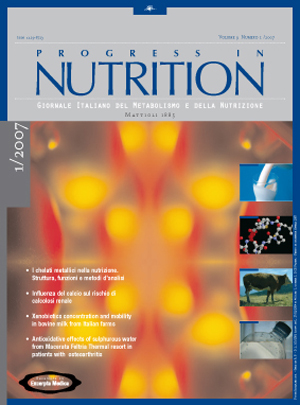Metal chelates in nutrition. Structural features, functions and analytical methods
Keywords:
Metal chelates, nutrition, organic trace minerals, analysis of metal chelatesAbstract
Mineral chelates (or metal chelates) in nutrition, i.e. the so-called organic trace minerals, represent the most outstanding proposal of mineral supplementation currently available on the market. They are formed by a transition metal ion (such as Zn2+, Cu2+) and one or more organic chelating molecules (ligands). It is now generally accepted that metal chelates are more bioavailable than the corresponding inorganic salts or oxides and, in spite of their higher price, their use appears nowadays useful or even necessary in some cases. The number of patents and scientific papers regarding production, properties and use of metal chelates is rapidly growing. Understanding mechanisms of their physiological behaviour is the most important target of current research in this field. Nevertheless, although in some cases the efficacy of mineral chelates has been demonstrated and helpful empirical correlations between physiological parameters and chelation strenght have been found, their mode of action is far from a definitive comprehension. In fact, the intrinsic nature of metal chelates is intriguing: they belong to a large family of chemical species, which, differently from organic molecules, are not easily recognizable by usual analytical methods. In addition, their stability in solution is strongly dependent on the acidity conditions (pH), on the nature of metal ions and ligands and on the presence in solution of other competitor chelating molecules (such as phytates). For these reasons, every study aimed to bring new sound contributions to the knowledge of physiological action of metal chelates, both in vivo and in vitro, should provide for scrupulous control both of the experimental conditions and of the nature of the used chelates. Aim of this paper is just to give useful informations to approach mineral chelates through two ways: (i) description of the structure of the main species of chelates available on the market; (ii) survey of presently suitable methods for qualitative and quantitative analysis of mineral chelates. Some of these methods are in course of experimental testing and validation at the Dipartimento di Chimica G.I.A.F. of the University of Parma by the “Gruppo di Studio sui Chelati Metallici per la Nutrizione Animale” in the framework of projects financed by Ministero dell’Università e della Ricerca (PRIN/04), by Regione Emilia-Romagna (PRRIITT) and by Regione Lombardia (FIT). (http://www.ricercaitaliana.it/prin/dettaglio_prin-2004038835.htm; http://www.chim.unipr.it/chelati/home.htm)
Downloads
Published
Issue
Section
License
This is an Open Access article distributed under the terms of the Creative Commons Attribution License (https://creativecommons.org/licenses/by-nc/4.0) which permits unrestricted use, distribution, and reproduction in any medium, provided the original work is properly cited.
Transfer of Copyright and Permission to Reproduce Parts of Published Papers.
Authors retain the copyright for their published work. No formal permission will be required to reproduce parts (tables or illustrations) of published papers, provided the source is quoted appropriately and reproduction has no commercial intent. Reproductions with commercial intent will require written permission and payment of royalties.

This work is licensed under a Creative Commons Attribution-NonCommercial 4.0 International License.


